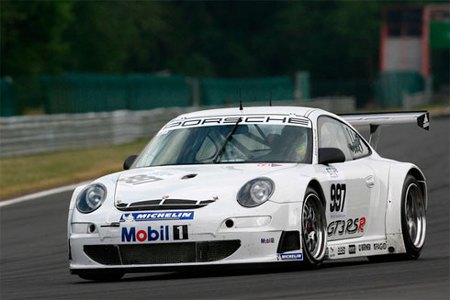ALMS GT2: Porsche 911 Uber Alles?
It's no secret that Porsche's 911 dominates the American Le Mans Series GT2 Class. Given their supremacy, you could almost say that the German marque owns the series, setting performance and reliability standards so high that any car other than a 911 is immediately classified as an hapless underdog. But the lap times they are a changin’. Sure, a Porsche has won a place on the podium at every race so far this season. Yes, they’ve scooped first place at half of those races. But a new breed of competition is finally giving the current 996 GT3 RSR a real run for the money. To review…
In 2004, a Ferrari broke Porsche’s GT2 supremacy by winning one race. In the 2005 season, team Panoz managed to repeat the feat to take the sole non-Porsche victory. The rest of the season volleyed between the Alex Job’s factory-supported 911 and the Petersen White Lighting “near factory supported” 911’s. All in all, Stuttgart’s finest won seven all-Porsche podiums and nine Porsche wins (out of ten races). Oh, and every top five championship team hailed from Stuttgart.
Porsche’s preeminence forced GT2 race fans to stake their allegiance on a racing team, rather than a car manufacturer. They chose their loyalties according to car color, driver nationality or whether or not a team was a privateer or factory supported. Fast forward to 2006 and it’s a whole new world. There hasn’t been a single 1-2-3 Porsche finish this season. In fact, Porsche is only batting .500; the mighty 911 has dropped three races to other manufacturers. Their biggest defeat: Panoz beating them to the checkered flag at both Sebring and Le Mans.
At the same time, the Ferrari F430 has become the class of the field. With a 4.0-liter V8 cranking out significantly more horsepower and torque than its F360 predecessor, with a new, stiffer chassis delivering a huge increase in torsional rigidity, with more highly evolved aerodynamics creating a huge increase in downforce, it's the one to watch.
Although the season didn’t start so well for the Italians, the team has since sorted the make’s famed reliability issues and eluded the bad luck that plagued their early efforts. In Portland, the Fezza came from dead last at the start to finishing first by a 20-second margin. The car also destroyed the competition at Salt Lake to take first place. That’s a far cry from the old F360, which only accounted for one victory during its entire stint in the series.
All in all, the lack of a new more competitive Porsche model in the GT2 class has created one of the best racing seasons in years. With the allowance of the GT2S class (which allows sedan-based cars to compete in the races but not for championship points), BMW has returned to the series. Lexus is about to make its debut with the new IS350 GT2. There have been a few races with three makes on the podium and five different teams taking the top spot. Better competition has made for great racing. And yet…
With its long history of class dominance, it’s no surprise that there’s still a Porsche team leading the American Le Mans Series GT2 point’s race. It’s also no shock that the out-gunned manufacturer is evolving its entry. The 997 GT3 RSR is based on the current gen 997 chassis, combined with a few pieces from the outgoing 996 GT3 RSR. Porsche has taken an unconventional step in the new car’s design: adding weight to enter a heavier class.
As the extra ballast can be placed anywhere in the car, the boffins at Porsche can now lower their car’s center of gravity and further refine the rear-engined machine’s handling. The move also frees the automaker to use wider wheels. To contain the new wider wheels, the car’s rear structure has been sourced from the Carrera 4 (which is now 50mm wider per side). The new chassis is ten percent stiffer than its predecessor. The new engine’s 3.8-liter displacement delivers 30 more horsepower than the 996’ 3.6-liter six, for a total of 485hp.
The 997 GT3 RSR made it racing debut at the Proximus 24 Hours of Spa. Despite the Jekyll and Hyde reliability of the RS Spyder, the new car finished 1-2 in their respective class.
The prospect of Porsche’s return to total supremacy must be giving GT2 race organizers nightmares. To their eternal credit, the sport’s governing body is not contemplating any sort of “equalizing” regulations to hamper the 911’s. It’s gloves-off racing like it should be. Even so, fans have mixed feelings. While the Porsches have established a large and loyal fan base, even the most die-hard supporter must secretly wish for more competitive racing. Will they have it? Watch this space.
More by Ryan Furst
Latest Car Reviews
Read moreLatest Product Reviews
Read moreRecent Comments
- Dave Holzman You're right about that!
- EBFlex It will have exactly zero effect
- THX1136 What happened to the other companies that were going to build charging stations? Maybe I'm not remembering clearly OR maybe the money the government gave them hasn't been applied to building some at this point. Sincere question/no snark.
- VoGhost ChatGPT, Review the following article from Automotive News: and create an 800 word essay summarizing the content. Then re-write the essay from the perspective of an ExxonMobil public relations executive looking to encourage the use of petroleum. Ensure the essay has biases that reinforce the views of my audience of elderly white Trump-loving Americans with minimal education. Then write a headline for the essay that will anger this audience and encourage them to read the article and add their own thoughts in the comments. Then use the publish routine to publish the essay under “news blog” using Matt Posky listing the author to completely subvert the purpose of The Truth About Cars.
- VoGhost Your source is a Posky editorial? Yikes.


































Comments
Join the conversation
911 Reliability? Ask the man who owns one: 84K miles in less than 3 years, a dozen track weekends a year (driven at a constant 6500 RPM scream, in the words of an advanced instructor, "the hardest I have ever seen a stock 911 driven"), ski weekends in NM, driven daily to work and on weekends everywhere...and NO expensive issues (dang few issues of any kind), doesn't use a drop of oil even during the track weekends. And let's talk maintenance engineering: EASY! Have done all my own maintenance on a dozen or more cars over 25 years, and this one is the easiest to work on by far. Yes, that rear engine takes a bit more work to drive fast than other cars do, but once you get that rhythm you're faster than virtually anything else, even guys who bring in well over 400 horses to big tracks like the Texas World Speedway road course. (One reason: That rear engine you guys are decrying means you can throttle steer the 911 much more effectively than virtually anything else. It just takes a bit of practice.) AND, that rear engine leaves plenty of room for luggage so you can take the lady of your life on a looong romantic weekend or even two-week vacation. If this is outmoded engineering, gimme more of it!
OMG!! - I haven't read so much ignoran BS since my last journey to the 'which is better Ford or Chevy' website. GBH - if the 911 is such a 'relic' and it, in your words, still sells and wins races. What does this say about the rest of the automotive industry? What have they been doing for the last 40 years? Because apparently, they still haven't figured out how to beat it?!? I think you'd be best to curl up with your physics book while the rest of us thrash around the track with perm-a-grin in our 911s. Your broad general comments are, in a word, irritating. You'd be a fool to sit here and argue that there is a 'best or worst' layout for an automobile. They all have short comings. The fact that Porsche have taken the least likely layout and made it into the most successful and one of the most recognized cars in the world is commendable to say the least. They took a chance and it has paid off for 40 yrs and counting. I've had many porsches from 928s/944 turbo/non-turbos/356s/912 and a half dozen 911s. They were/are all fantastic cars the most reliable so far have been the 356/912 and 911. 1983 SC with 185k miles has cost roughly $1500 in the last 20yrs!!and that is normal wear items brakes and clutch. 912 has approx 500K miles on it hasn't cost $10K yet. Yes, original owners of both and yes I maintain them myself. There's more to building cars than theory and my hats off to any manufacturer that has the b@!!$ to take a chance and the know how to make it work. Brgds, Peter